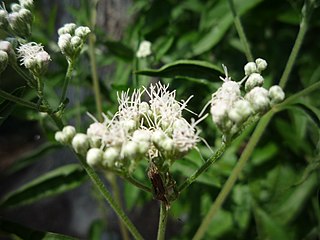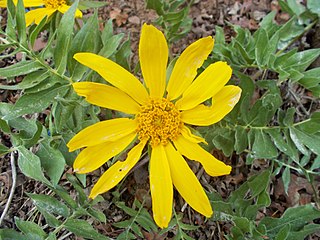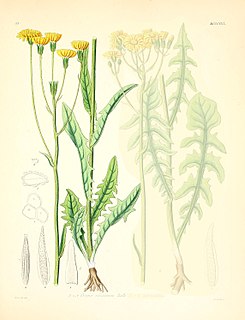
Eurybia macrophylla, commonly known as the bigleaf aster, large-leaved aster, largeleaf aster or bigleaf wood aster, is an herbaceous perennial in the composite family that was formerly treated in the genus Aster. It is native to eastern North America, with a range extending from eastern and central Canada through the northeastern deciduous and mixed forests of New England and the Great Lakes region and south along the Appalachians as far as the northeastern corner of Georgia, and west as far as Minnesota, Missouri and Arkansas. The flowers appear in the late summer to early fall and show ray florets that are usually either a deep lavender or violet, but sometimes white, and disc florets that are cream-coloured or light yellow, becoming purple as they mature. It is one of the parent species of the hybrid Eurybia × herveyi.

Helenium autumnale is a North American species of flowering plants in the sunflower family. Common names include common sneezeweed and large-flowered sneezeweed.

Eurybia sibirica, commonly known as the Siberian aster or arctic aster, is an herbaceous perennial native to north western North America and northern Eurasia. It is found largely in open areas of subarctic boreal forests, though it is also found in a wide variety of habitats in the region. It is similar in appearance to Eurybia merita, but their ranges overlap only near the border between the US and Canada, where E. sibirica is generally found at higher elevations.

Eupatorium altissimum, the tall thoroughwort, is a perennial plant whose native range includes much of the eastern and central United States and Canada (Ontario south to Nebraska, eastern Texas, the Florida Panhandle, and Massachusetts. It almost always grows on limestone soils, as does Brickellia eupatorioides, with which it is often confused. It can hybridize with Eupatorium serotinum.

Balsamorhiza is a genus of plants in the sunflower family known commonly as balsamroots. These are perennials with fleshy taproots and caudices bearing erect stems and large, basal leaves. Atop the tall stems are showy yellow sunflower-like blooms. Balsamroots are native to western North America.

Helenium amarum is a species of annual herb in the daisy family known by the common names yellowdicks, yellow sneezeweed, fiveleaf sneezeweed, and bitter sneezeweed. It is native to much of the south-central United States and northern Mexico, and it is present elsewhere in North America, Australia, and the West Indies as an introduced species.

Eupatorium serotinum, also known as late boneset or late thoroughwort, is a fall-blooming herbaceous plant native to North America.

Balsamorhiza deltoidea is a species of flowering plant in the sunflower tribe of the plant family Asteraceae known by the common name deltoid balsamroot. It is native to western North America from British Columbia to California, where it grows in many types of generally mountainous habitat.
Balsamorhiza macrolepis is a species of flowering plant in the sunflower tribe of the aster family, known by the common name California balsamroot. It is found only in California, where it grows in dry, open habitat, mostly in mountainous areas, mostly in the western foothills of the Sierra Nevada and in the eastern Coast Ranges near San Francisco Bay. It is now becoming rare in the Coast Ranges.

Balsamorhiza sagittata is a North American species of flowering plant in the sunflower tribe of the aster family known by the common name arrowleaf balsamroot. It is widespread across western Canada and much of the western United States. A specimen was collected by explorer and botanist Meriwether Lewis near Lewis and Clark Pass in 1806.

Balsamorhiza sericea is a species of flowering plant in the sunflower tribe of the plant family Asteraceae known by the common name silky balsamroot. It is native to the Klamath Mountains of northwestern California and southwestern Oregon, with additional populations in the Blue and Steens Mountains in eastern Oregon. It grows in rocky areas, sometimes on serpentine soils.

Helianthus occidentalis, the fewleaf sunflower or western sunflower, is a species of sunflower native to the Eastern and Central United States. It grows mostly in the Great Lakes Region and in the Ozarks, with additional populations scattered as far as Massachusetts, Texas, and the Florida Panhandle.

Heliopsis helianthoides is a species of flowering plant in the family Asteraceae, known by the common names rough oxeye, smooth oxeye and false sunflower. It is native to eastern and central North America from Saskatchewan east to Newfoundland and south as far as Texas, New Mexico, and Georgia.
Balsamorhiza incana is a North American species of plants in the sunflower tribe within the aster family. It is native to the northwestern United States, in Idaho, Montana, Wyoming, Washington, and Oregon.
Balsamorhiza rosea is a North American species of plants in the sunflower tribe within the aster family. It is native to the northwestern United States, in Washington and Oregon.

Balsamorhiza macrophylla is a North American species of plants in the sunflower tribe within the aster family. It is native to the northwestern United States, in Idaho, Montana, Wyoming, Utah, and Oregon.
Balsamorhiza serrata is a North American species of plants in the sunflower tribe within the aster family.
Balsamorhiza lanata, with the common name lanate balsamroot, is a species of plant in the sunflower tribe of the aster family native to California.

Crepis foetida is a European species of flowering plant in the daisy family with the common name stinking hawksbeard. It is widespread across much of Europe and Siberia, as well as being sparingly naturalized in scattered locations in the United States and Australia.

Crepis nicaeensis is a European species of flowering plant in the daisy family with the common names French hawk's-beard and Turkish hawksbeard. It is widespread across much of Europe, as well as being sparingly naturalized in scattered locations in the United States and Canada.















